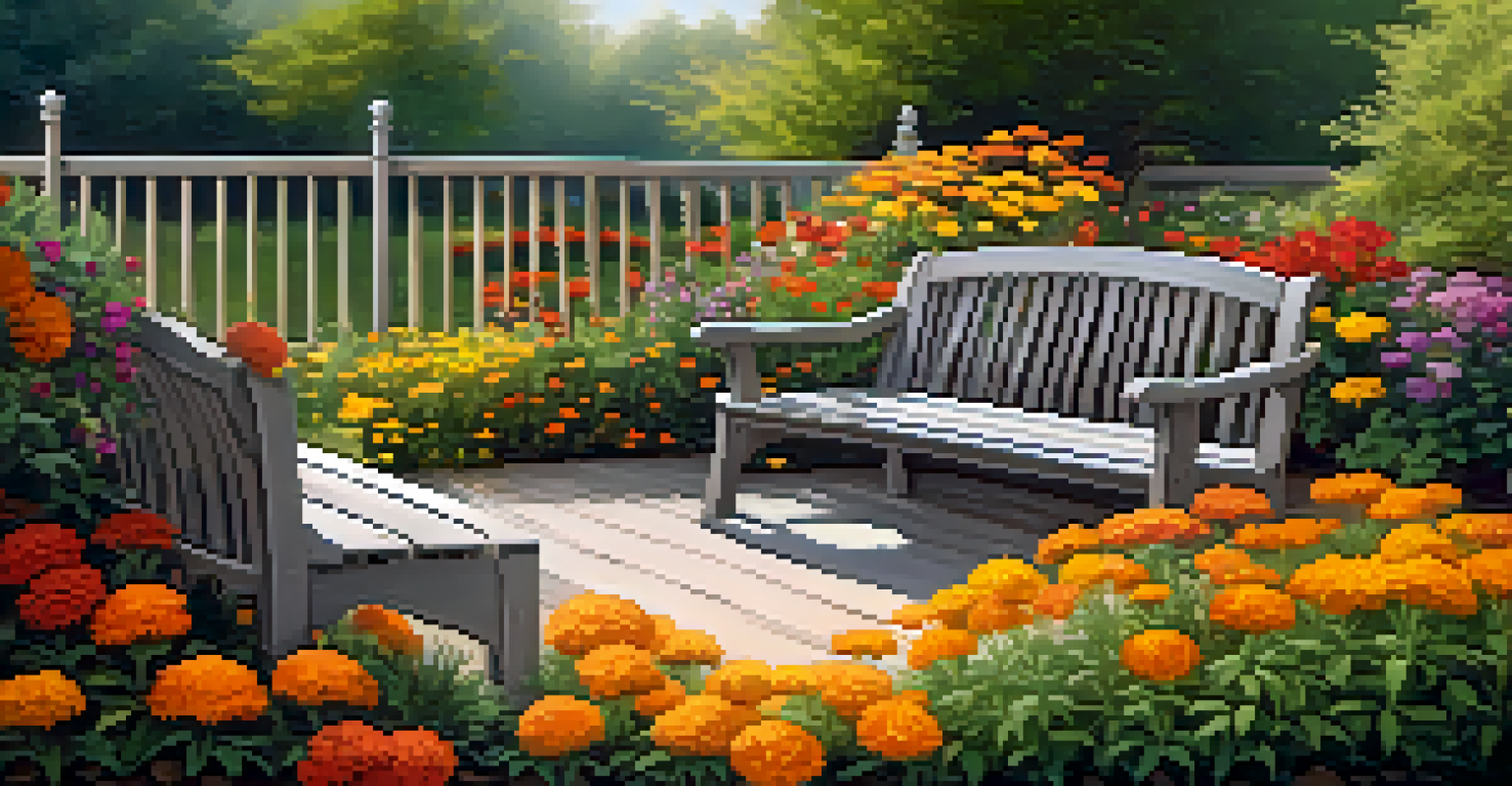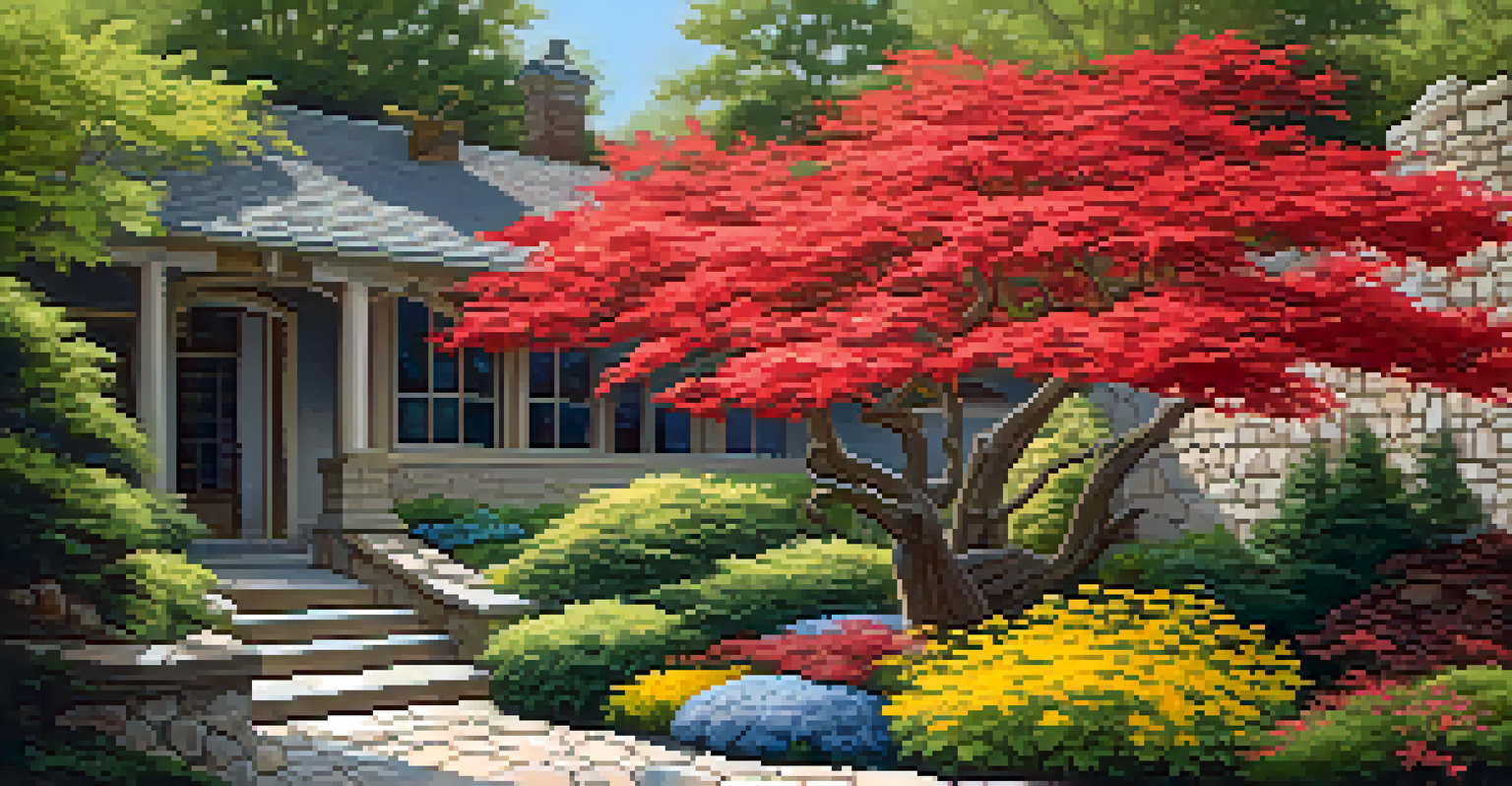Transform Your Landscaping with Colorful Plant Combinations

Why Color Matters in Landscaping Design
Color plays a crucial role in landscaping, as it can evoke emotions and set the mood for your outdoor space. Just like in a painting, the right combination of colors can create harmony, contrast, or even a sense of tranquility in your garden. Think of color as the personality of your landscape, giving it life and vibrancy.
Color is the keyboard, the eyes are the harmonies, the soul is the piano with many strings.
Moreover, different colors can influence how we perceive space; warm colors like reds and yellows can make an area feel cozy, while cool colors like blues and greens can provide a sense of openness. Understanding the psychological effects of colors can help you choose the right palette for your garden, ensuring it feels inviting and comfortable.
For instance, a garden filled with soft pastels may evoke a serene atmosphere, perfect for relaxation, while bold, bright colors can energize and excite. By being intentional about your color choices, you can transform your landscape into a true reflection of your style and the emotions you wish to convey.
Selecting the Right Plants for Color
When it comes to choosing plants, the options can be overwhelming. However, focusing on seasonal blooms can simplify your decision-making process. For instance, springtime favorites like tulips and daffodils offer vibrant colors, while summer perennials like coneflowers and daylilies provide lasting beauty.

Additionally, consider the foliage color, which can add depth and variety even when flowers aren't in bloom. Plants like purple heuchera or gold variegated hostas can provide stunning visual interest throughout the year. Mixing different textures and forms of foliage with your flowering plants can create a dynamic landscape.
Color Affects Landscape Mood
The right color combinations in landscaping can evoke emotions and set the desired atmosphere for your outdoor space.
Don't forget to think about the growth habits of the plants you select. Layering taller plants in the back and shorter ones in the front creates visual depth, enhancing the overall impact. A thoughtful combination of colors and shapes will ensure your garden remains captivating from every angle.
Creating Color Schemes: Monochromatic vs. Complementary
Color schemes can significantly influence the overall look of your landscape. A monochromatic scheme uses various shades of a single color, creating a cohesive and sophisticated appearance. For example, a garden filled with different hues of purple, from lavender to deep plum, can evoke a calming effect that’s easy on the eyes.
Gardening adds years to your life and life to your years.
On the other hand, complementary color schemes combine colors opposite each other on the color wheel, such as blue and orange or red and green. This approach draws attention and creates vibrant contrasts that can make your plants pop. It’s like setting a stage where each plant plays a vital role in the performance of your garden.
Experimenting with these schemes can lead to stunning results. Visualize how different combinations come together; you might find that mixing a bold color with softer tones creates a balanced, eye-catching display. The key is to play around with your options until you find a combination that resonates with you.
Incorporating Seasonal Color into Your Landscape
Seasonal color is a fantastic way to keep your landscape exciting throughout the year. By selecting plants that bloom in different seasons, you can ensure there’s always something colorful in your yard. Spring bulbs, summer annuals, and fall foliage all contribute to a dynamic visual experience.
For instance, consider planting spring-flowering bulbs like hyacinths for their vibrant colors, followed by summer blooms such as zinnias or sunflowers. As fall approaches, trees and shrubs with colorful leaves, like maples and burning bushes, will maintain interest in your landscape. This seasonal rotation keeps your garden fresh and engaging.
Seasonal Plants Keep Interest
Incorporating plants that bloom in different seasons ensures your landscape remains vibrant and engaging year-round.
Moreover, incorporating evergreens can provide structure and color during the winter months. Their rich greens can contrast beautifully against the snowy backdrop, ensuring your landscape is visually appealing year-round. By planning for seasonal color, you can create a landscape that evolves beautifully with the changing seasons.
Creating Focal Points with Colorful Plants
Focal points are essential in landscaping, as they draw the eye and create interest. Incorporating colorful plants as focal points can enhance your landscape dramatically. For example, a vibrant red Japanese maple or a striking blue hydrangea can serve as a captivating centerpiece in your garden.
To make a focal point even more effective, consider its surroundings. Positioning colorful plants against a neutral backdrop, like a wooden fence or a stone wall, can help them stand out even more. This technique is akin to spotlighting a star on stage, allowing it to shine and capture attention.
Another approach is to use bold colors in clusters, creating a dramatic effect. This method can transform an ordinary garden bed into a stunning display, making it the highlight of your outdoor space. By thoughtfully placing colorful plants, you can guide visitors through your landscape and keep their interest piqued.
Using Color to Define Spaces in Your Landscape
Color can also be a powerful tool for defining different areas within your landscape. By using specific color palettes, you can create distinct zones that serve various purposes, such as relaxation, entertainment, or play. Imagine a cozy seating area surrounded by warm-toned flowers, inviting you to unwind.
Conversely, cooler colors in a play area can create a lively, energetic atmosphere that encourages activity. For example, bright yellows and blues can stimulate excitement and fun for children. This thoughtful use of color helps to establish the mood and function of each space within your garden.
Focal Points Enhance Visual Appeal
Using colorful plants as focal points can draw the eye and create captivating centers of interest in your garden.
Additionally, pathways lined with colorful plants can guide the eye and encourage exploration. By strategically placing vibrant colors along walkways, you create a visual journey throughout your landscape. This not only enhances the overall experience but also adds a layer of depth and intrigue to your outdoor design.
Maintaining Your Colorful Landscape Combinations
Once you've created your colorful landscape, maintenance is key to keeping it looking vibrant. Regular watering, pruning, and fertilizing will ensure your plants thrive and continue to produce eye-catching blooms. Think of it as nurturing a friendship; the more care you give, the stronger it grows.
Additionally, consider seasonal clean-up, like removing spent blooms and dead leaves, which can help your garden look tidy and vibrant. Mulching can also enhance the colors of your plants while preventing weeds and retaining moisture. A little bit of effort goes a long way in maintaining the beauty of your landscape.

Lastly, don’t forget to reassess your plant combinations periodically. As seasons change and plants mature, some may require rethinking. Embracing this ongoing journey of discovery can keep your garden fresh and exciting, ensuring it remains a colorful haven for you and your visitors.